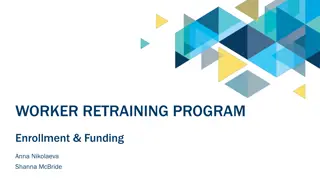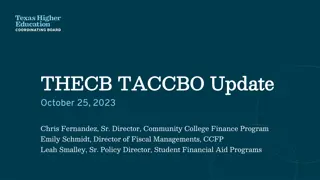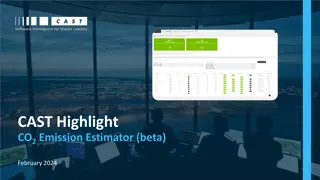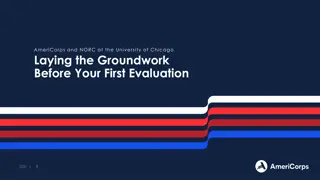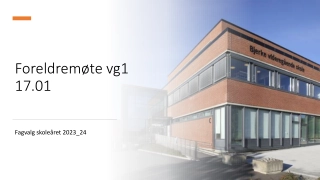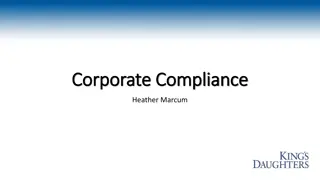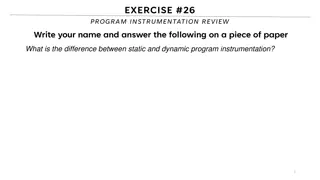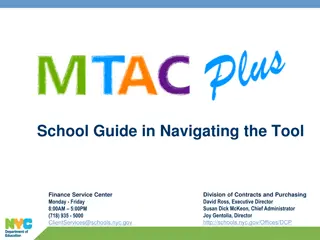Understanding the Minimum Foundation Program (MFP) Formula
The Minimum Foundation Program (MFP) Formula in Louisiana is crucial for determining the cost of education and distributing state funds equitably. This program follows a budgeting cycle from August to December, with BESE submitting the formula to the Legislature for adoption by March 15th. The current MFP formula, House Concurrent Resolution 23, consists of four levels with distinct allocations catering to various educational needs. Level 1, which calculates the State share allocation, plays a significant role in determining funding based on student enrollment and attendance.
Understanding the Minimum Foundation Program (MFP) Formula
PowerPoint presentation about 'Understanding the Minimum Foundation Program (MFP) Formula'. This presentation describes the topic on The Minimum Foundation Program (MFP) Formula in Louisiana is crucial for determining the cost of education and distributing state funds equitably. This program follows a budgeting cycle from August to December, with BESE submitting the formula to the Legislature for adoption by March 15th. The current MFP formula, House Concurrent Resolution 23, consists of four levels with distinct allocations catering to various educational needs. Level 1, which calculates the State share allocation, plays a significant role in determining funding based on student enrollment and attendance.. Download this presentation absolutely free.
Presentation Transcript
Overview of the Minimum Foundation Program (MFP)Formula
MFP Purpose Article VIII, Section 13 of the Louisiana Constitution provides that the Board of Elementary and Secondary Education (BESE) shall annually develop and adopt a formula which shall be used to: Determine the cost of a minimum foundation program of education in the State. Equitably distribute State funds through the formula. 2
MFP Formula Budgeting Cycle August to December - LDOE conducts research as needed January to February - Task Force makes recommendations to BESE on possible revisions to the formula for the upcoming fiscal year March - BESE makes final decision on formula components and submits proposed formula and estimated cost to the Legislature. April to June - Legislature considers the formula July - Adopted formula implemented in new fiscal year 3
MFP Adoption Process The formula for the upcoming fiscal year must be submitted by BESE to the Legislature for consideration no later than March 15th. Possible outcomes include: Formula is adopted then implemented July 1 in new fiscal year. Formula is returned to BESE with suggestions for revisions, then BESE has the option to revise and resubmit or take no action. Formula is not passed then current formula remains in effect for upcoming fiscal year. 4
MFP Formula Structure The current formula, House Concurrent Resolution 23, has four Levels, each with a separate and distinct allocations. Each level has separate calculations to provide funding for different educational needs. 5
MFP Level 1 Level 1 calculates the State share allocation and this allocation totals over two- thirds of the total MFP funding. Level 1 has three calculations in order to determine the State share allocation. First, the formula calculates the cost of education in each school system. The cost calculation begins with the number of students enrolled and actively attending school. The MFP Membership Definition as adopted by BESE defines the students that may be counted for funding purposes. 6
MFP Level 1 The student count includes: Base student count - The total number of students enrolled and actively attending school on February 1. Each student counts as one (1.0) in this data set. Weight student count The number of students qualifying to be counted in each of the weights. 7
MFP Level 1 Weights, defined as a percentage, is a mathematical solution to recognize additional costs associated with educating certain special populations of students. For example, a weight of 60% adds .60 of a student. This .60 is added to the base count of 1.0 so that the student is counted as 1.60 which totals the Weighted student count. 8
MFP Level 1 The formula includes five different weights: Economically Disadvantaged (ED) Weight (22%) recognizes the additional cost associated with educating students that are economically disadvantaged. Students are eligible to be counted if they qualify for programs such as Medicaid and reduced price lunch eligibility as of February 1. Career and Technical Education Weight (6%) designed to recognize the additional costs incurred for supplies for CTE courses. CTE unit is equal to each course in which a student is enrolled as of October 1 for the entire school year. 9
MFP Level 1 Students with Disabilities Weight (150%) - acknowledges the extra cost that is incurred to provide services to students with disabilities. Students are eligible to be counted if they are receiving one of the 16 identified special education services and have a current IEP as of February 1. Gift and Talented Weight (60%) - recognizes the additional cost associated with providing services to gifted and/or talented students. Students are eligible to be counted if they qualify as gifted and/or talented and have a current education plan as of February 1. 10
MFP Level 1 Economy of Scale Weight(up to 20%) - City and parish School systems with less than 7,500 students are recognized to have extra costs due to their small size. These systems are assigned extra weighted students in order to recognize this extra cost. The number of students is determined by how close or distant they are from 7,500 students. Systems farthest away from 7,500 students would be allocated approximately 20% while systems nearest to 7,500 would be allocated a much smaller percentage. 11
MFP Level 1 The weighted student or unit counts are added to the base student count to equal the total weighted student count. 12
MFP Level 1 Table 3 13
MFP Level 1 The Base Per Pupil amount is the next component in the Level 1 formula calculation. This amount is specifically named in the formula resolution adopted by the Legislature. Level 1 is the only level of the formula in which this amount is utilized. The per-pupil amount is an input not an output; it is NOT the final per-pupil allocation that each school system receives when the Level 1 calculation is complete. The current base per-pupil amount is $4,015. 14
MFP Level 1 Total weighted student count is multiplied by the base per pupil amount to equal the cost of education calculated by the formula. 15
MFP Level 1 Table 3 16
MFP Level 1 The second Level 1 calculation determines the portion of the cost that is funded by the State through the MFP and the portion that is supported by the local school systems. The formula ensures that the total State share is maintained at 65% while the total local share is maintained at 35%. The local share of the cost is determined first and is calculated based on the potential of school systems to generate local tax revenues in support of education. The calculation uses the potential to raise revenue rather than actual revenue collected to recognize the variation in the abilities of the school systems to generate funds. 17
MFP Level 1 To measure the potential to raise local revenue, first, the net assessed taxable property value for each city and parish school system is utilized. The net assessed taxable property amounts are gathered from the Louisiana Tax Commission. To lessen the volatility of the allocation, a growth in the net assessed property value is capped at 10% per year. Table 7 18
MFP Level 1 Additionally, the full potential to raise local revenue also includes the sales tax base. Sales tax revenue is divided by the sales tax rate to equal the sales tax base. To lessen the volatility of the allocation, a growth in the sales tax base is capped at 15% per year. Table 7 19
MFP Level 1 The net assessed taxable property for each city and parish school system is multiplied by a calculated ad valorem millage and the sales tax base is multiplied by the calculated sales tax rate required to ensure the 65%/35% split in cost is maintained. Finally, Other Revenues (Revenues in Lieu of Taxes + 50% of 16thSection Land and other real estate earnings) are added to the projected yield of property and sales tax revenue to equal the total local share deduction. Table 6 20
MFP Level 1 Next, the local share deduction/allocation is subtracted from the total cost of education to equal the State share. Total Cost of Education State Share Allocation Local Share Allocation = Minus The State share portion is always 65%, but each individual school system will have a unique State share based on its unique student counts, net assessed property, sales tax base and other revenues. The proportion of the cost funded by the State may range, from a high of 89% to a low of 25%. The proportion may change upward or downward on an annual basis. 21
MFP Level 2 Level 2 was implemented to provide an incentive to school systems to tax themselves beyond the minimum required to meet the local share. When this formula was first developed in the early 1990s some school systems were not generating local revenues sufficient to meet the required local contribution. As of today, all local school systems have passed taxes at a level that is beyond the minimum. The minimum required local revenue share is equal to the local share allocation in Level 1. Local Share Allocation Minimum Local Revenue Share = 22
MFP Level 2 The Level 2 allocation measures the extra effort through the total local tax revenues (property, sales, and other revenues) actually collected. Local revenues above the minimum required is the difference between the total local tax revenues collected compared to the Level 1 local share allocation. Local Revenue Over Minimum Total Local Tax Revenues Local Share Allocation = Minus 23
MFP Level 2 The maximum reward is equal to 34% of the Total Level 1 costs. Total Level 1 Cost 34% Cap Maximum on Level 2 x = The amount eligible to be considered for a Level 2 allocation is the Local revenue over the minimum compared to the maximum on Level 2. Amount Eligible for Level 2 Local Revenue Over Minimum Maximum on Level 2 minus = 24
MFP Level 2 The amount eligible for a Level 2 is multiplied by a set factor of 1.72 and the Level 1 local share allocation percent to equal the Level 2 local allocation. Amount Eligible for Level 2 Local Share Allocation Level 1 Local Share % x = x 1.72 The local allocation is then subtracted from the amount eligible for a Level 2 allocation to equal the Level 2 State share allocation. Amount Eligible for Level 2 Local Share Allocation State Share Allocation - = 25
MFP Level 2 Table 3 26
MFP Level 3 Level 3 provides three allocations : 1 - Continuation of Prior Year Pay Raises - Continues funding for teacher and support worker pay raises originally provided by the Legislature the 2000s. 2- Historical Formula Allocation A one-time hold harmless provision instituted in the early 1990s when the current student driven formula was implemented to ease transition. 3 - Support for Increasing Mandated Costs of Health Insurance, Retirement, and Fuel - $100 per student to defray the costs of these expenses implemented in mid-2000s. 27
MFP Level 4 Level 4 provides funding for six specific programs : 1 International Teacher Allocation - Funding to support the cost of employing international teachers for language instruction including: $21,000 per teacher towards salary expenses installation stipend for first-year teachers retention stipend for second and third- year teachers. 2 - Career Development Fund (CDF) Allocation Funding to support the cost of specific courses providing career training and certifications. 28
MFP Level 4 3 - Supplemental Course (SCA) Allocation - Funding to support the cost of secondary course choices above and beyond the traditional classroom including dual enrollment. 4 - High Cost Services (HCS) Allocation School systems apply for funding to assist with the cost of services for a student with disabilities when the cost of the services are greater than three times the average per student cost. 29
MFP Level 4 5 - Certificated and Support Worker Pay Raises - Funding for the continuation of: $1,000 certificated personnel pay raise along with a $500 Support Worker pay raise plus associated retirement costs that was provided first in 2019-20. $800 certificated personnel pay raise along with a $400 Support Worker pay raise plus associated retirement costs was provided in 2021-22. $1,500 certificated personnel pay raise along with a $750 Support Worker pay raise plus associated retirement costs that was provided first in 2022-23. 30
MFP Level 4 8 Teacher Mentor Stipend Allocation Supports Teacher Mentors to undergraduate year-long residents and post-baccalaureate certification residents with a $2,000 stipend. 31
MFP Level 4 Level 4 also contains allocations for: Lab Schools LSU and Southern Lab Schools ULL Lab School (opening in future year) State schools Office of Juvenile Justice (OJJ) Schools New Orleans Center for Creative Arts (NOCCA) Louisiana School for the Math, Science, and the Arts (LSMSA) Thrive Academy Special School District (SSD) 32
MFP Level 4 State-authorized public schools Type 2 Legacy Charter Schools Type 2 Legacy Charter schools were authorized by the State Board of Elementary and Secondary Education before July 1, 2008. There are currently seven Legacy Type 2 charter schools in operation. Students are funded based the Charter Per Pupil by residency for both a State and local allocation. Allocation includes a State and a local portion funded entirely by the State. 33
MFP Level 4 New Type 2 Charter schools The Type 2 charter schools were authorized beginning July 1, 2008; currently there are thirty-seven schools in operation. The allocation is based on the Charter Per Pupil by residency for the State and local allocation. The local allocation is supported via the local revenue representation transfer. The administrative fee due to the LDOE (.25%) is calculated and removed from the total State and local allocation prior to release to the schools. This transaction occurs twice per year. 34
MFP Level 4 Recovery School District (RSD)/Type 5 Charter Schools RSD operated and Type 5 Charter schools receive a State allocation based on the MFP per pupil for the school system in which the school is physically located. The local allocation is based on the Charter per pupil, funded with the local revenue representation. The administrative fee due to the RSD (1.75%) and LDOE (.25%) is calculated and removed from the total State and local allocation prior to release to the schools. This transaction occurs twice per year. 35
MFP Adjustments MFP funding is adjusted in March to incorporate student increases or decreases reported by the school systems during the most recent October and February student counts. The size of the funding adjustment depends on the difference in the student count, upward or downward, multiplied by the unique State share per pupil amount. Changes in the October student count require an adjustment for the full per pupil amount but changes in the February count only require one-half of the per pupil amount. 36
Questions For more information on the Minimum Foundation Program (MFP), reference the following link to the MFP Library: http://www.louisianabelieves.com/resources/library/ minimum-foundation-program Questions may be sent to LDOEMFPHelpdesk@la.gov 37


